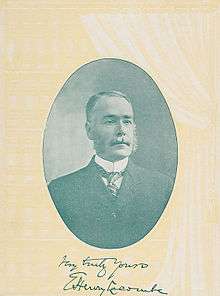Emile Henry Lacombe
| Emile Lacombe | |
|---|---|
 | |
| Judge of the United States Court of Appeals for the Second Circuit | |
|
In office June 16, 1891 – February 15, 1916 | |
| Preceded by | Seat established |
| Succeeded by | Charles Hough |
| Judge of the United States Circuit Court for the Second Circuit | |
|
In office May 26, 1887 – June 16, 1891 | |
| Appointed by | Grover Cleveland |
| Preceded by | Seat established |
| Succeeded by | Seat abolished |
| Personal details | |
| Born |
January 29, 1846 New York City, New York, U.S. |
| Died |
November 28, 1924 (aged 78) New York City, New York, U.S. |
| Education | Columbia University (BA, LLB) |
Emile Henry Lacombe (January 29, 1846 – November 28, 1924) was a judge in the United States.
Lacombe obtained his undergraduate degree from Columbia University and his law degree from Columbia Law School in 1865. He engaged in the private practice of law in New York for many years. He also served as a New York City Assistant Corporation Counsel from 1874 to 1884 and then as Corporation Counsel (the city's chief attorney) from 1884 to 1887.
In 1887, President Grover Cleveland appointed Lacombe to serve on the United States Circuit Court for the Second Circuit, headquartered in New York. In 1893, when Ny Look a Chinese Civil War veteran was arrested for not registering under the Geary Act which required all unregistered Chinese to be arrested and deported, Lacombe ruled in In re Ny Look that there were no deportation provisions in the law and Look could not be detained indefinitely therefore he should be released.[1]
In 1909, he reluctantly conferred American citizenship on Bhicaji Balsara, a Parsi thought to be the first Indian to become a U.S. citizen. Whilst Lacombe conceded that Balsara ‘appears to be a gentleman of high character and exceptional intelligence’. He was reluctant to confer citizenship as he reasoned that there “was much force in the argument that the Congress which framed the original act for naturalization of aliens ...intended it to include only white persons belonging to the races whose emigrants had contributed to the building up on this continent of the community of people which declared itself a new nation ..." Lacombe only gave Balsara citizenship on the hope that the United States attorney would indeed challenge his decision and appeal it to create “an authoritative interpretation” of the law. As Lacombe felt if, the definition of ‘free white persons’ was to be extended ... it... [would] bring in, not only the Parsee.,… which is probably the purest Aryan type, but also Afghans, Hindoos, Arabs, and Berbers.”
The U.S. attorney adhered to Lacombe’s wishes and took the matter to the Circuit Court of Appeals in 1910. The Circuit Court of appeal agreed that Parsees belong to the white race and were "as distinct from Hindus as are the English who dwell in India”.[2]
After Congress passed the Evarts Act establishing the United States Courts of Appeals, Lacombe's judgeship was reassigned to the Appeals Court. Lacombe served as an appellate judge on the Second Circuit until 1916, when he retired and returned to private practice. He died in 1924 and is buried in Evergreen Cemetery in Morristown, New Jersey.
Lacombe wrote a letter to the New York Times advancing a conspiracy theory about the German sinking of the RMS Lusitania in 1915. His letter was published Monday October 22, 1917 on page 14 titled "A NEW THEORY OF THE LUSITANIA SINKING. The Evidence of the German Medal Dated May 5 and the Report of the Explosive "Cigars" on Board."[3]
References
- ↑ “The Ny Look Case,” Washington Post, May 28, 1893, p. 4; “The Ny Look Test Case,” New York Times, May 26, 1893, p. 4; In re Ny Look, C.C. New York (1893), 56 Fed. 81; “Notes on Recent Decisions,” Minnesota Law Journal vol. 1, no. 4 (August 1893), 86.
- ↑ Postmodernism & a Sociology...(c). University of Arkansas Press. pp. 143–. ISBN 978-1-61075-322-7.
- ↑ https://timesmachine.nytimes.com/timesmachine/1917/10/22/102369146.pdf
Sources
- Emile Henry Lacombe at the Biographical Directory of Federal Judges, a public domain publication of the Federal Judicial Center.
| Legal offices | ||
|---|---|---|
| New seat | Judge of the United States Circuit Court for the Second Circuit 1887–1891 |
Seat abolished |
| Judge of the United States Court of Appeals for the Second Circuit 1891–1916 |
Succeeded by Charles Hough | |